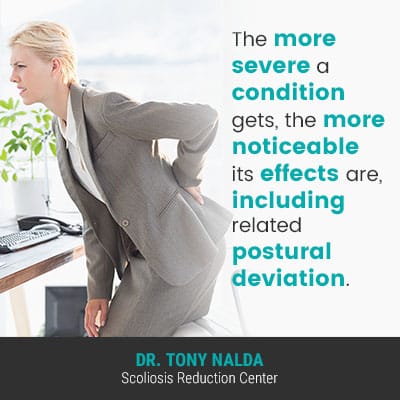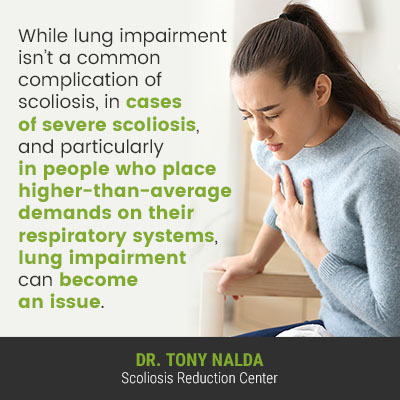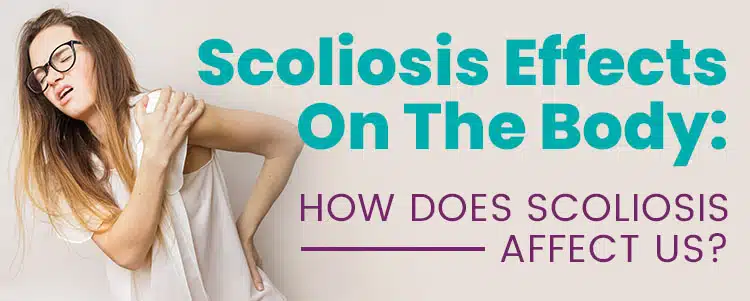As part of the central nervous system that facilitates brain-body communication, the spine is involved in the function of virtually every working system within the body, so spinal conditions like scoliosis can cause a wide range of effects that aren’t just isolated to the back. Continue reading to learn about the many ways in which scoliosis can affect the body, particularly if severe and left untreated.
Scoliosis is a structural spinal condition that involves a loss of the spine’s healthy curves. As the spine works in tandem with the brain to form the body’s central nervous system, the effects of scoliosis aren’t just felt in the back, but throughout the body, particularly when severe.
Scoliosis affects different people in different ways, and there are a number of variables that shape a person’s experience of life with scoliosis, so let’s start there.
Diagnosing and Classifying Scoliosis
First of all, in order to reach a diagnosis of scoliosis, certain parameters have to be met; scoliosis involves the development of an unnatural sideways spinal curve with rotation and a minimum Cobb angle of 10 degrees.
The rotational component is what makes scoliosis a 3-dimensional condition as the spine doesn’t just bend unnaturally to the side but also twists from front to back, back to front.
A patient’s Cobb angle is a measurement taken during an X-ray that involves drawing intersecting lines from the tops and bottoms of the most-tilted vertebrae of the curve, and the resulting angle is expressed in degrees.
Cobb angle measurements tell me how far out of alignment a scoliotic spine is while classifying conditions based on severity:
- Mild scoliosis: Cobb angle measurement of between 10 and 25 degrees
- Moderate scoliosis: Cobb angle measurement of between 25 and 40 degrees
- Severe scoliosis: Cobb angle measurement of 40+ degrees
- Very-severe scoliosis: Cobb angle measurement of 80+ degrees
Condition severity is an important variable that informs the crafting of effective treatment plans and factors into how the condition will affect the body.
The higher the Cobb angle, the more severe the condition is, and the more it’s going to affect the body adversely, which is why proactive treatment is so important.
Part of the diagnostic process involves comprehensively assessing conditions so they can be further classified based on important patient/condition variables: patient age, condition severity, curvature location, and condition type.
Classifying conditions is important for streamlining the treatment process, and also guides the design of effective treatment plans.
As you can see, there are a lot of factors that can vary from one patient to the next, which is why scoliosis affects people differently and the condition’s complex nature necessitates a customized treatment approach.
So now that we’ve talked about how scoliosis is diagnosed and classified, let’s move on to discuss the many ways in which it can affect the body.
Scoliosis is Progressive
A key condition feature to understand is that scoliosis is progressive, which means it’s in its very nature to worsen over time, particularly if left untreated or not treated proactively.
Scoliosis progressing and getting worse means the unnatural spinal curve is increasing in size, and as scoliosis introduces a lot of uneven forces to the body, as the condition worsens, so too do its uneven forces and effects on the body.
So, where a patient’s scoliosis is at the time of diagnosis is not indicative of where it will stay, especially if left untreated.
Even a patient who’s diagnosed with mild scoliosis can easily progress to moderate, severe, or very severe, and the only way to counteract the condition’s progressive nature is through proactive treatment.
In addition, as a scoliotic curve increases in size, it gets more rigid, and this makes it less responsive to treatment, and the more time the body has to adjust to the unnatural curve’s presence, the harder it is to correct.
While there are no treatment guarantees, early detection, when responded to with proactive treatment, does increase the chances of treatment success as there are fewer limits to what we can achieve.
So how does scoliosis affect us: in a myriad of ways that can differ from one patient to the next.
Let’s start with how scoliosis affects the appearance of the body, as in most cases of scoliosis, postural deviation is its main visual symptom.
Scoliosis and Postural Deviation
As mentioned, scoliosis introduces a lot of uneven forces to the body, which is why in the condition’s most-prevalent form, adolescent idiopathic scoliosis (AIS) diagnosed between the ages of 10 and 18, a postural deviation is its main symptom.

The uneven forces of the condition affect the body by causing noticeable asymmetries in the skeletal system, and depending on severity, these changes can range from subtle to overt.
Cases of mild scoliosis often cause subtle postural changes that are only noticeable to those specifically trained in the condition’s early telltale signs, which is one of the reasons early detection isn’t always easy to achieve.
The more severe a condition gets, the more noticeable its effects are, including related postural deviation.
The ways in which scoliosis affects body symmetry and posture can include:
- Uneven shoulders, with one sitting higher than the other
- Uneven shoulder blades with one protruding more on one side than the other
- Uneven eye tilt
- The development of a rib arch
- Uneven hips with one sitting higher than the other, or one appearing more rounded, or flatter, than the other
- An uneven waistline
- Arms and legs that appear to hang at different lengths
- A prominent lean to one side (most visible when in a forward-bend position)
In addition to these forms of postural deviation, other related bodily effects include clothing becoming ill-fitting and changes to gait, balance, and coordination are related to a shift in the body’s center of gravity.
So how does scoliosis affect the body visually: by introducing uneven forces that disrupts the body’s overall symmetry, and now, let’s address how scoliosis can affect the body’s nervous system.
Scoliosis and the Nervous System
As the spine and brain work together to form the body’s central nervous system (CNS), spinal conditions like scoliosis can also interfere with signals from the nervous system and overall brain-body communication.
There are 31 pairs of spinal nerves that are considered mixed nerves because they carry the motor, sensory, and autonomic signals between the spinal cord and the rest of the body.
When a scoliotic curve develops, it can compress and stretch nerves located along the unnatural curve’s inner and outer edge, which means the spinal nerves are exposed to uneven pressure.
When a spinal nerve is exposed to uneven pressure, it can become irritated, inflamed, compressed, or impinged, and as a result, affected nerves are less able to conduct important signals to and from the body’s extremities.
Nerves are like branches of a tree, fanning off in multiple directions, so when a nerve is exposed to uneven pressure at its root or anywhere along its pathway, its effects can be felt far from its site of origin.
Scoliosis becomes a compressive condition in adulthood, which is why adults find the condition painful, while children and adolescents generally don’t; prior to reaching skeletal maturity, the spine undergoes a constant lengthening motion due to growth, and this counteracts the compressive force of the unnatural spinal curve.
So while postural deviation is the main symptom of scoliosis in children and adolescents, for adults, it’s pain: localized back pain or radicular pain felt throughout the body.
Radiating pain, known as radiculopathy, can include icy-hot tingling sensations in the arms and legs, the sensation of pins and needles, and electric shock-like pains.
In addition to strange sensations, radiculopathy can also impair fine and gross motor control; remember, spinal nerves are mixed nerves that control sensation and motor control.
Gross motor control refers to large muscle groups guiding large types of movement like running and jumping, whereas fine motor control involves the use of small muscles for performing intricate tasks like clicking small items together with the fingers.
In severe cases, radiculopathy can also cause issues with bowel and bladder control.
Scoliosis and the Digestive System
In a healthy spine, its vertebrae (bones) are stacked on top of one another in a straight and neutral alignment, but as scoliosis involves the spine deviating from its natural position, it is encroaching on the space used/needed for other parts of the body to function within, like its internal organs.
Digestion starts with the mouth and esophagus by chewing and swallowing and involves a variety of organs, the stomach and intestines, so what happens when scoliosis comes into play?
For people with severe scoliosis, facial muscles that facilitate chewing can suffer from different levels of dysfunction, and when scoliosis involves the cervical spine (neck), the esophagus (a muscular tube used to swallow and transport food from the mouth to the stomach) can be constricted, causing difficulties with swallowing.
Further down the digestive tract, we have the stomach and small intestines that are in charge of breaking down food molecules into nutrients.
In a healthy digestive system, as food is broken down into nutrients, these essential nutrients are passed from the small intestine into the bloodstream by absorption, while unnecessary food byproducts end up in the large intestine prior to excretion.
When the stomach and intestines are facing compression due to scoliosis, it can affect the digestive system in the following ways:
- Impairing the ability to absorb essential nutrients
- Build-up of stomach acid that can cause acid reflux and nausea
- Irritable bowel syndrome (IBS)
- Feeling satiated prior to nutritional needs being met
- Constipation
- Weight loss
- Incontinence
Scoliosis can affect the digestive system in terms of its speed and overall function.
Scoliosis and Muscular Imbalance
It’s not just the spine that’s responsible for maintaining its natural curves and alignment, but also its surrounding muscles.
Approximately 80 percent of known scoliosis cases are idiopathic, meaning we don’t fully understand what caused them to develop initially, and particularly in idiopathic scoliosis, patients often overcompensate for their postural asymmetries with their muscles.
Even children and adolescents, who aren’t yet vulnerable to the compressive aspect of scoliosis, experience related muscle pain.
As an unnatural spinal curve develops, its surrounding muscles are struggling to support and stabilize the spine, and this can cause uneven wear and tear on the spine’s surrounding muscles, which can cause them to become stiff, sore, and painful.
Improper muscle use worsens posture even more and can cause chronic back pain, and any section of the body that’s experiencing postural deviation will have its muscles affected as they try to compensate for the asymmetries and counteract the condition’s uneven forces.
Scoliosis and Headaches
Now, we’ve already addressed how scoliosis can affect the brain in terms of brain-body communication and nervous system signals, but it can also affect the levels of cerebrospinal fluid (CSF) in and around the brain.
Scoliosis is associated with headaches, with the potential of reaching migraine status, and this is due to a disruption in the flow of cerebrospinal fluid.
Cerebrospinal fluid contains nutrients needed by the brain and supports, cushions, and protects the brain and spinal cord from the effects of sudden jarring motions. For example, if a person has no CSF, shaking the head could bruise the brain, whereas a person with adequate levels of CSF can shake the head safely because the brain is cushioned and protected by its surrounding cerebrospinal fluid, thereby preventing damage.
So not only can scoliosis cause tension headaches due to muscle imbalances (cervical scoliosis), but the condition can also prevent the recirculation of CSF to the brain, and lower levels of CSF in and around the brain can turn an average headache into a migraine.
Scoliosis and the Menstrual Cycle
We know that female adolescents are ten times more likely to develop scoliosis than males, and we also know that scoliosis is more likely to progress in females, and this is thought to to be the result of puberty: females tend to start earlier than males, and growth and development is the condition’s main progressive trigger.
It’s also been noticed that adolescent females with scoliosis tend to start menstruating later than peers of a similar age without scoliosis, and scoliosis is also associated with irregular periods and fluctuating hormone levels.
There are countless theories that attempt to explain the development of idiopathic scoliosis, and one such theory is that scoliosis is caused by low levels of specific female hormones, such as progesterone, which can affect the reproductive system.
As the nerves that run through the spine connect the brain to the body, including its organs, it makes sense that scoliosis can also affect hormones and cause irregular menstrual cycles.

Scoliosis and Breathing
While lung impairment isn’t a common complication of scoliosis, in cases of severe scoliosis, and particularly in people who place higher-than-average demands on their respiratory systems, lung impairment can become an issue.
Again, a spine that deviates from its normal position means it is encroaching on the space used by other parts and systems within the body, and the lungs are no exception.
Particularly in cases of thoracic scoliosis (middle/upper back), the unnatural spinal curve can pull on the rib cage, causing the development of a rib arch, and this can reduce the space available for the lungs to function within, making it difficult to inhale and exhale fully. This can also affect a person’s ability to get a good night’s rest by making it difficult to settle into a normal breathing rhythm during sleep.
Scoliosis and Pain
While the nature of scoliosis pain has been addressed throughout the article in each relevant section, I feel it warrants its own section to address the topic clearly.
Remember, as scoliosis doesn’t become compressive until skeletal maturity has been reached, back and/or radicular pain, due to compression, is not generally a part of the child/adolescent experience of life with scoliosis. However, pain is the main symptom that brings adult patients in to see me for a diagnosis and treatment, and this most often involves radicular pain felt in the arms, legs, and feet.
That being said, adolescents and adults alike can experience other types of pain caused by their scoliosis, as previously discussed: muscle pain, headaches, lung impairment, digestive issues, etc.
When it comes to pain management, there is a big difference between treating patients with scoliosis and treating scoliosis itself; this is an important distinction to understand because addressing scoliosis pain solely as a symptom, but not its underlying cause, tends to produce short-term pain relief (prescription medications), while proactive treatment that addresses the underlying structural nature of the condition can actually correct scoliosis for long-term sustainable pain management.
Scoliosis and Mental Health
Too often, the effects of medical conditions on mental health aren’t fully understood, or prioritized.
While a life with scoliosis doesn’t have to be limiting or define a person in any way, it does pose extra challenges, and the many ways in which it can affect the body can attest to that, including mental health.
When we’re talking about AIS, the condition’s most prevalent form, we’re talking about adolescents: teenagers who want nothing more than to fit in with their peers.
This age group doesn’t want to look different or walk differently. They want to wear the clothes they like and be confident enough to wear a bathing suit in public, and scoliosis can affect these aspects of daily life.
In addition, depending on severity, activity restrictions can also come into effect, and this can greatly impact a person’s ability to live their best life, particularly for athletic adolescents.
The stress of living with an incurable, progressive spinal condition like scoliosis can be extremely difficult to deal with, and its effects on mental health can also disrupt the body’s responsiveness to treatment.
Also, keep in mind, regardless of age, any one of the aforementioned condition effects can impact a person’s ability to get a good night’s rest and enjoy daily life, so for both adolescents and adults, the effects of scoliosis aren’t just physical, but can also be psychological.
Conclusion
As a progressive structural spinal condition that causes a loss of its healthy curves, scoliosis can affect the body in a myriad of unexpected ways.
From postural deviation, back, and radicular pain, to digestive issues, lung impairment, irregular menstrual cycles, and the stress of living with a progressive spinal condition, the effects of scoliosis can be far-reaching.
As such a highly-variable condition that can range from mild to moderate and severe to very severe, what one patient experiences, in terms of symptoms and effects, isn’t a reliable indicator of what others will face.
Here at the Scoliosis Reduction Center®, my goal is to minimize the condition’s effects by proactive treating the underlying cause of the condition’s symptoms: the condition itself.
By working towards impacting the condition, first and foremost, on a structural level, I can reduce the unnatural spinal curve through chiropractic care, and through a variety of in-office therapies, I can work towards increasing core strength so the spine’s surrounding muscles can provide it with optimal support.
By introducing corrective bracing at the right time, it can complement other forms of treatment by augmenting corrective results, and custom-prescribed home exercises can help establish a home-rehabilitation program to further stabilize the spine for long-term sustainable results.
So when it comes to dealing with scoliosis’s effects on the body, the best time to start treatment is always now so there is a chance of preventing further progression, increasing condition severity, escaping symptoms, and the need for more invasive treatment in the future.




